|
|
|
|
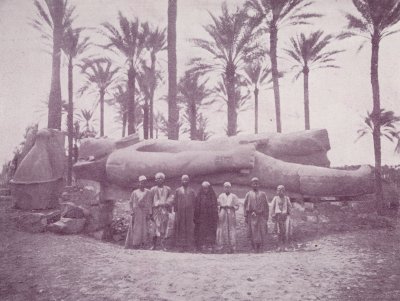
|
|
The Sepulchral
Monument of Ramses
"The above is a
correct photographic view of the ruins of the immense and once magnificent
Monument of Ramses, in the Biban-El-Melook. Ramses, or Ramseses, was
one of the several kings of Egypt of the nineteenth dynasty, and resided
at Thebes. He not only, while yet a young man, conquered a
number of confederate nations of Central Asia, but several European and
African nations, and his empire at one time extended far south into Nubia,
the ancient Ethiopia. He erected many temples and fortresses in
foreign lands, and embellished all Egypt with magnificent edifices.
As will be seen, the monument is rapidly decaying".
|
|
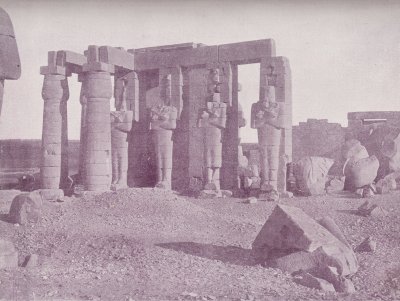
|
|
Prostrate Statue of
Ramses
The site of
ancient Thebes, in Egypt, and upon the Nile, is an immense amphitheatre,
in which the traveler is at first bewildered by the confusion of ruined
portals, obelisks, statues and columns, which tower above the palm
trees. Gradually the magnificent ruins of Luxor locate themselves
over on the east side of the river. Opposite them, on the west side,
sit in dignified repose the two mammoth statues of Memnon. Back of
those statues , and 500 yards nearer the Lybian desert, stood the
Rameseion, an Egyptian Westminster Abbey, the remains of whose massive
columns and gigantic statuary show that they were erected in honor of the
families or reigns of the Ramseses. The Rameseion at Thebes is
before you in the illustration, as it appears today. It was both
palace and temple. The sculptures were quaint and vivid.
Several Ramesid Columns remain standing, but the hugest of all lies
prostrate before the others, and broken in two in the middle. Its
weight is estimated at 887 tons, and it measures 22 feet 4 inches across
the shoulders. It is of Syene granite, and its removal from Syene to
Thebes is a mystery to modern engineers.
|
|
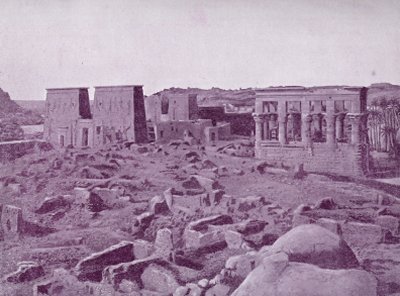
|
|
Ruins of Philae,
Egypt, From the South
Philae is an
island on the Nile, anciently consecrated to Isis and Osiris. There
was also a city of the same name, now Jeziret el Birbeh. The ruins
depicted in the illustration are among the most celebrated remains of
antiquity. To the Egyptologist especially they present material for
boundless interest. Isis, it will be remembered, was both sister and
wife to Osiris, who was the father of Horus and Anubis. Horus was
the sun, and Anubis that Egyptian deity represented with the head of a
dog, the tutelary god of the chase. The most elementary acquaintance
with Egyptian mythology suggests its similarity with the beautiful system
of the ancient Greeks. The learned visitor to Philae finds
"sermons in stones and good in everything' he sees there".
|
|
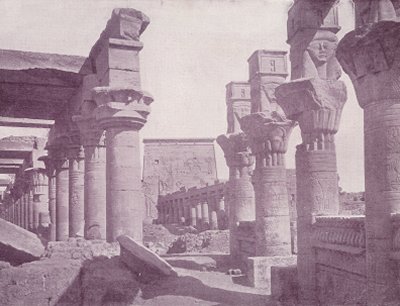
|
|
Ruins at Philae "There
is but a single sentiment in the minds of every Nile traveler when the
ruins of Philae are reached, and that is, that they are the most
magnificent of the Egyptian architectural remains. This is not
because they are so stupendous as the pyramids, or so imposing as the
mighty remnants at Thebes and Karnak, but because at Philae nature steps
in to help art. The spot of these massive ruins, which are those of
a temple dedicated to Isis, is the island of Philae, in the midst of the
first cataract of the Nile, and just south of the boundary between Egypt
and Nubia. The island is of granitic formation, and here was
quarried and carved the material for the Philae temples, as well as for
many of the obelisks, temples, pyramids and sarcophagi found elsewhere in
the Nile valley. While these remains at Philae are essentially
Egyptian, their better state of preservation and some of the columnar
effects lead archaeologist to give them a later date than those of Luxor,
Karnak and Thebes. There are eight sites of ruins on this single
island, all seemingly pointing to the worship of Isis". |
|
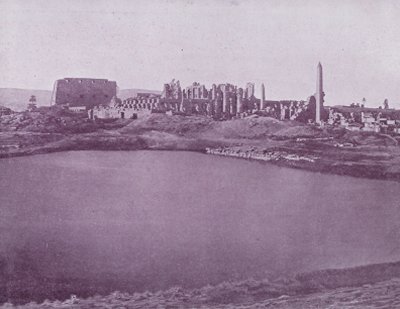
|
|
Karnak, Egypt
"This wonder of the
world is in the Theban amphitheatre on the Nile, and its ruins are Theban,
though on the opposite or eastern side of the river. So vast and
solemn are the ruins of Karnak that they sweep beyond imagination.
In front is the lake, both natural and artificial. Backward sweep
those majestic ruins which were once the glory of Thebes. Karnak was
a bewildering series of temples of such proportion as to dwarf modern
measurements. You see one in the illustration whose front wall is
379 feet long and whose tower is 150 feet high. Leading to this is
an avenue 200 feet long lined with sphinxes. Inside of all is the
main room, 329 feet by 170 feet, supported by 134 columns, over 60 feet
high and 12 feet in diameter, and all highly sculptured and delicately
colored. This is pronounced by all travelers to be the most
magnificent ruin in the world".
|
|
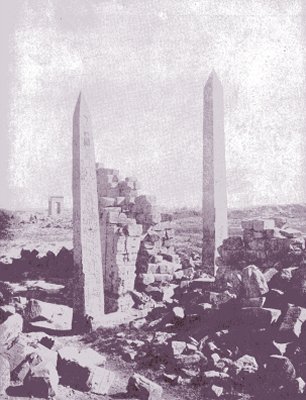
|
|
The Standing Obelisks,
Karnak, Egypt
"Karnak is the name
of the village built on the ruins of ancient Thebes. Little is left
of this ancient capital, the city of a hundred gates, 'as sung by
Homer'. Two colossal statues of Rameses II are lying prone on the
ground, and the Temple of Sarapis is full of archaeological
interest. This is the famous Temple of the Sacred Bulls honored by
the ancient Egyptians as successive incarnations of Osiris. While
they lived they inhabited the Temple of Aphis, and after their death and
embalmment they were buried in a temple made in the desert for the
reception of their mummies. The sight of this structure was
discovered in 1850 by M. Mariette; and afterward the sands hiding the
ruins were removed. Readers who have seen the obelisk in the Central
Park, New York, will be quite at home with the principal objects shown in
the illustration, which, like that, have engraved upon them characters
very tantalizing to the unlearned".
|
|
|
